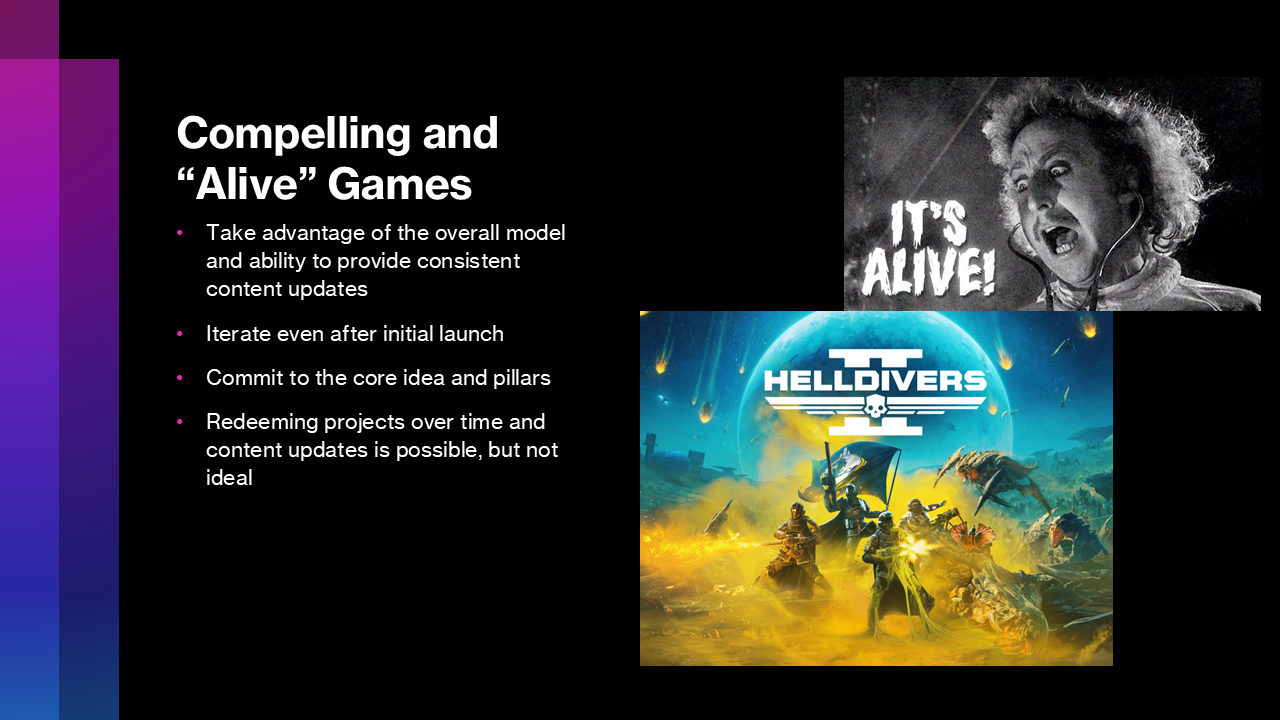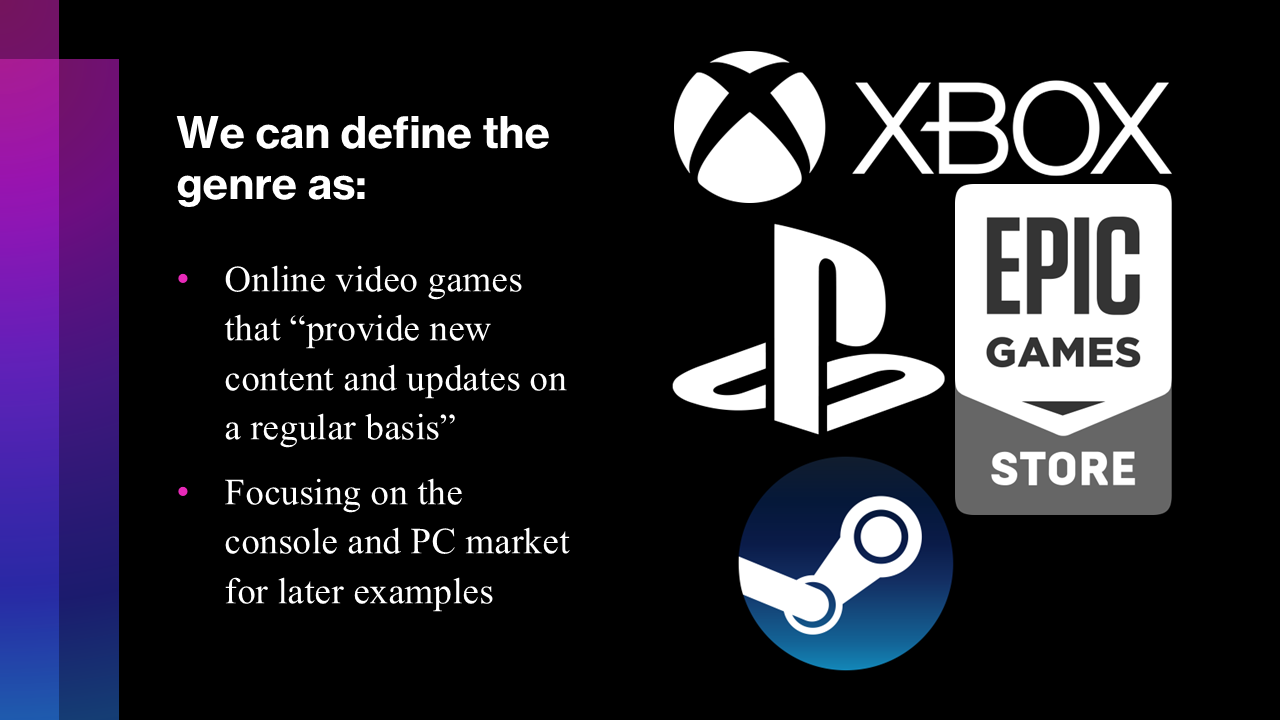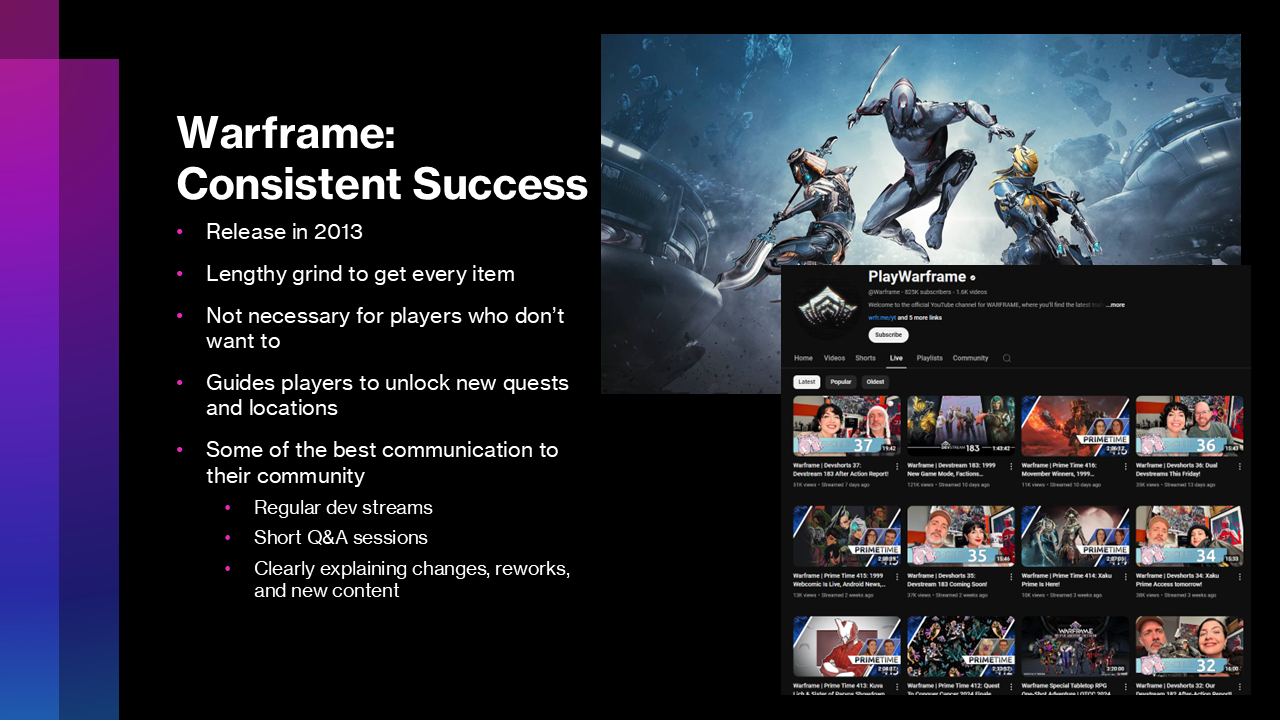This is my gaming industry deep dive project created for the professional development course within the Sheridan Honours Bachelor of Game Design program on the topic of games as a service and how it has affected player perception of games and industry development.
Presented in 2024 to my peers. Special thanks to Chris Crowell.
______________________________________
- Project Information -
Full essay viewable with the link below.
Game design research and industry analysis.
Individual Project.
Approximate 4 month development time.
2024.
__________________________________________________________________________________________________________
- Presentation and Summary -
What are we defining as a live service game in this context?
We’re going to be focusing primarily on the pc and console market for later game examples, but in short, live service games are online video games that provide new content and updates on a regular basis.


- What makes live service different? -
Well, development doesn’t stop after the game launches. There are often plans for content to be made after initial launch. This can result in simultaneous development of content to consistently deliver. Which is very taxing on both companies and developers. While heavily simplified, you can see on the diagram to the right, there can be content in pre-production, production, and something that just launched all happening at the same time on the same game. Some new problems that have come up for developers from this model are getting large game file sizes over long term from the updates, and those continuous updates mean a growing code base, and more bugs. Declining player counts and low player retention are also notable issues that developers have to solve for games to be successful


These titles rely on player retention and monetization in game to stay online. However, when not designed in player friendly ways, this can lead to players feeling like they are being led by a carrot on a stick for rewards in a slow and monotonous progression system, as well as the commodification of play time as a result.
- Some game examples and scenario's -
Warframe, being my example of a consistent success, has been around for over ten years now. And while it has a lengthy grind to get all the weapons, Warframe's, and other items, that grind is not all there is and isn’t necessary for players who don’t want to engage with that. Warframe guides players to unlock its quests and new locations, instead of leading players along to an unknowable reward that always seems just out of reach. Warframe and its developers also have some of the best communication between the studio and their community, featuring regular streams as you can see from their YouTube channel, Q&A sessions, and they clearly show players new content, changes, and feedback from their community in an active way to improve the game.


My second example, and a recent success, is Helldivers 2. It takes full advantage in its design of games as a service and features a live galactic conquest scenario that is monitored by a dedicated game master on the team. It has a focus on community goals in game, where every mission you do counts towards liberating a planet. And these systems are supported by that idea of having an evolving game.
My third example, and one that is a commercial failure, is Anthem. There is a lot to learn here about Studio Health, as the game was developed for 7 years but only put into production in the last 18 months before launch. Because of that it launched with a lot of bugs, very little content on launch, and it completely exhausted developers at the studio. While Anthem attempted to recover, further development was cancelled in 2021 due to COVID-19.


The last game example and a game that was able to recover from an initial failure is No Man’s Sky. It also launched with a lot of bugs, many missing features that were promised, including multiplayer, base building, space battles, and many more that the community had an ongoing list. However, two years later it released on Xbox with a successful major update and overhaul to the game, and now has recovered itself after delivering on those initial promises. The studio behind it, Hello Games, listened to player expectations, and got to work focusing on recovering the game.
- What can we learn as an industry? -
Player retention needs to be done the right way, and a game can’t be designed around artificially increasing this metric, where retention and keeping the player logged in, is driving gameplay. Instead, the gameplay should drive retention from players wanting to have a positive experience and play a fun game.


The short history of live service as also shown us that there needs to be a focus on studio health. Live service game development can be chaotic, the health of a studio needs to be prioritized over shipping an unfinished and buggy game. Because healthy development teams have clear visions, and the capacity to create fun games that are healthy on launch and last.
My third lesson learned here is that live service is done best when developers take advantage of the model to provide consistent updates and iterate even after launch, as shown with Helldivers 2 and Warframe. Committing to the core idea and pillars and building on that to create an engaging experience. While redeeming projects is possible over time, as shown with No Man’s Sky, it's far from being ideal.


Finally, communication goes both ways between the studio and players. Active communication with a community of players is incredibly important to keep people engaged as shown with Warframe, it allows for direct feedback to the studio, and an easy way for players to connect with the community. At the end of the day, players won’t play a game they don’t like, and community is a big part of developing a live service game, so it's best to take advantage and listen to what players are looking for.
- Conclusion -
Looking to the future, I look forward to seeing where the industry goes with games as a
service and the potential it brings in creating fun and engaging experiences for communities of
players. The industry can learn a lot from what has been done so far and use the lessons learned
to create games that players will enjoy, and developers will enjoy making for their audience
without worrying about crunching to meet the final launch, or that the game will not be a
commercial success.
service and the potential it brings in creating fun and engaging experiences for communities of
players. The industry can learn a lot from what has been done so far and use the lessons learned
to create games that players will enjoy, and developers will enjoy making for their audience
without worrying about crunching to meet the final launch, or that the game will not be a
commercial success.

^Full list of references here^
__________________________________________________________________________________________________________
- All Original Slide Images Below -


















